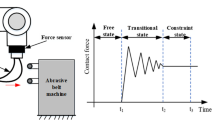Abstract
Abrasive belt grinding is gradually recognized as an effective machining technology for blade. However, the complex contact characteristics of this technology make the grinding quality of blade unable to be precisely controlled. In order to solve this problem, a parametric control method for precision abrasive belt grinding of blade was proposed, and a multi-parameter test platform for state parameters (grinding force, vibration, and temperature) was established. The grinding experiments of nickel-based superalloy samples were carried out, and the prediction model of state parameters based on back propagation neural network was constituted. The prediction accuracy of the model was 93.58%. On this basis, the grinding experiments of nickel-based superalloy blade were conducted. The influence of state parameters on the evaluation parameters (material removal, profile accuracy, surface quality) was analyzed and the optimal grinding parameters were determined. The experimental results showed that the machining quality of new-type aeroengine blades can be effectively improved by this parametric control method and model.














Similar content being viewed by others
References
Fu YZ, Wang XP, Gao H, Wei HB, Li SC (2016) Blade surface uniformity of blisk finished by abrasive flow machining. Int J Adv Manuf Technol 84(5-8):1725–1735. https://doi.org/10.1007/s00170-015-8270-0
Klocke F, Zeis M, Klink A (2015) Interdisciplinary modelling of the electrochemical machining process for engine blades. CIRP Ann Manuf Technol 64(1):217–220. https://doi.org/10.1016/j.cirp.2015.04.071
Li X, Meng FJ, Cui W, Ma S (2015) The CNC grinding of integrated impeller with electroplated CBN wheel. Int J Adv Manuf Technol 79(5-8):1353–1361. https://doi.org/10.1007/s00170-015-6904-x
Cho SS, Ryu YK, Lee SY (2002) Curved surface finishing with flexible abrasive tool. Int J Mach Tools Manuf 42(2):229–236. https://doi.org/10.1016/S0890-6955(01)00106-7
Axinte DA, Kritmanorot M, Axinte M, Gindy NNZ (2005) Investigations on belt polishing of heat-resistant titanium alloys. J Mater Process Technol 166(3):398–404. https://doi.org/10.1016/j.jmatprotec.2004.08.030
Xiao GJ, Huang Y (2016) Equivalent self-adaptive belt grinding for the real-R edge of an aero-engine precision-forged blade. Int J Adv Manuf Technol 83(9-12):1697–1706. https://doi.org/10.1007/s00170-015-7680-3
Pandiyan V, Tjahjowidodo T, Samy MP (2016) In-process surface roughness estimation model for compliant abrasive belt machining process. Proc CIRP 46:254–257. https://doi.org/10.1016/j.procir.2016.03.126
Pandiyan V, Caesarendra W, Tjahjowidodo T, Praveen G (2017) Predictive modelling and analysis of process parameters on material removal characteristics in abrasive belt grinding process. Appl Sci Basel 7(4). https://doi.org/10.3390/app7040363
Wang YJ, Huang Y, Chen YX, Yang ZS (2016) Model of an abrasive belt grinding surface removal contour and its application. Int J Adv Manuf Technol 82(9-12):2113–2122. https://doi.org/10.1007/s00170-015-7484-5
Xiao GJ, Huang Y (2017) Adaptive belt precision grinding for the weak rigidity deformation of blisk leading and trailing edge. Adv Mech Eng 9(10):12. https://doi.org/10.1177/1687814017731705
Serpin K, Mezghani S, El Mansori M (2015) Multiscale assessment of structured coated abrasive grits in belt finishing process. Wear 332:780–787. https://doi.org/10.1016/j.wear.2015.01.054
Subrahmanya N, Shin YC (2008) Automated sensor selection and fusion for monitoring and diagnostics of plunge grinding. J Manuf Sci Eng-Trans ASME 130(3):11. https://doi.org/10.1115/1.2927439
Nguyen D, Yin SH, Tang QC, Son PX, Duc LA (2019) Online monitoring of surface roughness and grinding wheel wear when grinding Ti-6Al-4 V titanium alloy using ANFIS-GPR hybrid algorithm and Taguchi analysis. Precis Eng J Int Soc Precis Eng Nanotechnol 55:275–292. https://doi.org/10.1016/j.precisioneng.2018.09.018
Cheng C, Li JY, Liu YM, Nie M, Wang WX (2019) Deep convolutional neural network-based in-process tool condition monitoring in abrasive belt grinding. Comput Ind 106:1–13. https://doi.org/10.1016/j.compind.2018.12.002
Pandiyan V, Caesarendra W, Tjahjowidodo T, Tan HH (2018) In-process tool condition monitoring in compliant abrasive belt grinding process using support vector machine and genetic algorithm. J Manuf Process 31:199–213. https://doi.org/10.1016/j.jmapro.2017.11.014
Zou L, Liu X, Huang Y, Fei Y (2019) A numerical approach to predict the machined surface topography of abrasive belt flexible grinding. Int J Adv Manuf Technol 104(5-8):2961–2970. https://doi.org/10.1007/s00170-019-04032-2
Guo MX, Li BZ, Ding ZS, Liang SY (2016) Empirical modeling of dynamic grinding force based on process analysis. Int J Adv Manuf Technol 86(9-12):3395–3405. https://doi.org/10.1007/s00170-016-8465-z
Liu Y, Li Q, Xiao GJ, Huang Y (2019) Study of the vibration mechanism and process optimization for abrasive belt grinding for a Blisk-Blade. IEEE Access 7:24829–24842. https://doi.org/10.1109/Access.2019.2899495
Yan SJ, Xu XH, Yang ZY, Zhu DH, Ding H (2019) An improved robotic abrasive belt grinding force model considering the effects of cut-in and cut-off. J Manuf Process 37:496–508. https://doi.org/10.1016/j.jmapro.2018.12.029
Zou L, Huang Y, Zhang G, Cui X (2019) Feasibility study of a flexible grinding method for precision machining of the TiAl-based alloy. Mater Manuf Process 34(10):1160–1168. https://doi.org/10.1080/10426914.2019.1628255
Ren X, Cabaravdic M, Zhang X, Kuhlenkotter B (2007) A local process model for simulation of robotic belt grinding. Int J Mach Tools Manuf 47(6):962–970. https://doi.org/10.1016/j.ijmachtools.2006.07.002
Cheng J, Li YC, Zhou JH, Liu JZ, Cen KF (2010) Maximum solid concentrations of coal water slurries predicted by neural network models. Fuel Process Technol 91(12):1832–1838. https://doi.org/10.1016/j.fuproc.2010.08.007
Arriandiaga A, Portillo E, Sanchez JA, Cabanes I, Zubizarreta A (2017) Recurrent ANN-based modelling of the dynamic evolution of the surface roughness in grinding. Neural Comput Applic 28(6):1293–1307. https://doi.org/10.1007/s00521-016-2568-1
Klocke F, Soo SL, Karpuschewski B, Webster JA, Novovic D, Elfizy A, Axinte DA, Tonissen S (2015) Abrasive machining of advanced aerospace alloys and composites. CIRP Ann Manuf Technol 64(2):581–604. https://doi.org/10.1016/j.cirp.2015.05.004
Dai CW, Ding WF, Zhu YJ, Xu JH, Yu HW (2018) Grinding temperature and power consumption in high speed grinding of Inconel 718 nickel-based superalloy with a vitrified CBN wheel. Precis Eng J Int Soc Precis Eng Nanotechnol 52:192–200. https://doi.org/10.1016/j.precisioneng.2017.12.005
Erdik T, Sen Z (2009) Prediction of tool wear using regression and ANN models in end-milling operation a critical review. Int J Adv Manuf Technol 43(7-8):765–766. https://doi.org/10.1007/s00170-008-1758-0
Funding
This work was supported by the National Natural Science Foundation of China (Grant No. 51875064) and the Fundamental Research Funds for the Central Universities (Grant No. 2019CDJGFJX003).
Author information
Authors and Affiliations
Corresponding author
Additional information
Publisher’s note
Springer Nature remains neutral with regard to jurisdictional claims in published maps and institutional affiliations.
Rights and permissions
About this article
Cite this article
Li, Z., Zou, L., Yin, J. et al. Investigation of parametric control method and model in abrasive belt grinding of nickel-based superalloy blade. Int J Adv Manuf Technol 108, 3301–3311 (2020). https://doi.org/10.1007/s00170-020-05607-0
Received:
Accepted:
Published:
Issue Date:
DOI: https://doi.org/10.1007/s00170-020-05607-0




